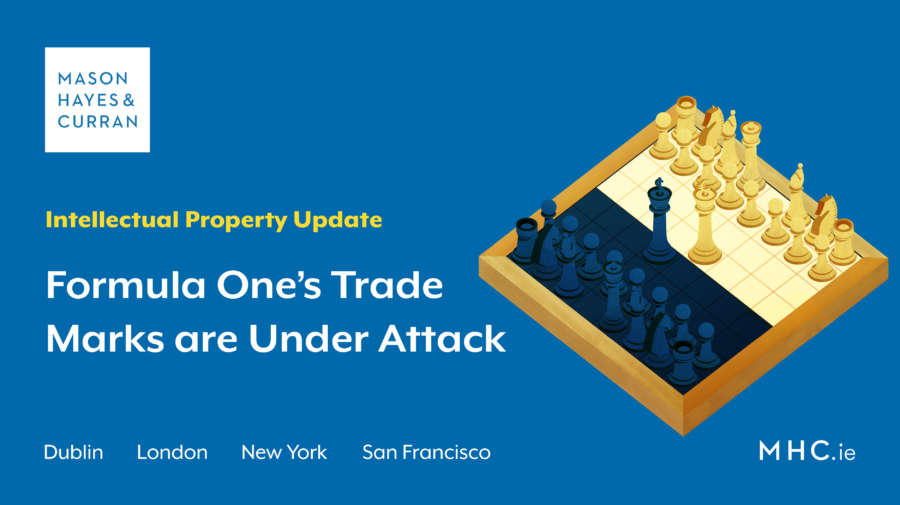
Formula One Licensing B.V has been faced with 69 revocation proceedings against its EU trade marks, all brought by one applicant. Formula One submitted that the applicant in question was focused on a personal vendetta and that this amounted to an abuse of law and process. Head of Intellectual Property, Gerard Kelly discusses the outcome in this case and the principles the EUIPO will consider when assessing whether an application filed with them abuses law and process.
Since 2018, Formula One Licensing B.V. (Formula One) has accumulated 69 revocation applications against its EU trade marks. All of these applications have been made by the same applicant, Mr Dieter Hang. In March 2023, the EUIPO Cancellation Division considered two of these applications which pertained to the ‘Formula 1’ word mark and the ‘F1 Formula 1’ figurative mark, respectively. The applications for revocation were partially upheld. Mr Hang argued that the marks had not been put to genuine use for the contested goods and services for five years prior to the filing of the revocation applications.
The Cancellation Division found that the evidence provided by Formula One was not sufficient to show use for all of the registered goods and services. As a result, they revoked the registrations for the contested goods and services for which there was no evidence of use. However, a key issue considered in these cases was whether there was an abuse of process by Mr Hang, based on the amount of revocation applications he had submitted against Formula One’s trade marks.
Formula One’s arguments
Formula One contended that the proceedings should be rejected in their entirety as numerous revocation requests amounted to an abuse of law. They sought to rely on the Sandra Pabst[1] case in which the proprietor claimed that the revocation application had been filed as an abuse of law, alleging that the applicant had intended to blackmail them. In finding that there had been an abuse of rights and process in that case, the EUIPO Grand Board had considered the particular circumstances of the case, such as, the retaliatory nature of the application and the number of revocation requests, etc.
In the issue at hand, Formula One found the number of applications to be unreasonable and the expectation that they could compile all of the evidence within short time limits, to be as equally unreasonable. As a result of the applications, Formula One was forced to let a large portion of their trade marks lapse through surrender so that they could concentrate their efforts on defending their core trade marks.
Formula One claimed that Mr Hang had been motivated to bring the applications by a personal vendetta. The tension between the parties began in 1998 when Formula One filed oppositions against a number of Mr Hang’s trade marks, such as ‘Formel 1’ and ‘Planet Formel 1’. In response, Mr Hang initiated cancellation proceedings and filed oppositions against Formula One’s trade marks. Mr Hang had also filed a criminal complaint against Formula One and their legal representatives, but these charges were considered unfounded by the Public Prosecution Office.
As a result of the string of proceedings between the parties, Mr Hang’s German trade mark for ‘Formula 1’ had been cancelled. This led to another onslaught of cancellation proceedings brought by Mr Hang against Formula One in the EUIPO, relying on another one of his German trade marks, ‘Formel 1’. In defence, Formula One brought cancellation proceedings against that German mark and it was also cancelled. Following on from this, Mr Hang continued to file numerous revocation applications against Formula One in the EUIPO on the basis of non-use for certain goods and services. This amounted to a total of 69 applications by June 2021.
In the most recent proceedings, Formula One argued that Mr Hang’s business focused on the sale of medals and coins under the names ‘Formel 1’ and ‘Formula1’. They claimed their trade marks for ‘F1’ and ‘GRAND PRIX’, which were also being challenged, were completely disconnected from Mr Hang’s business and this showed that the revocation applications were simply being directed at the entirety of Formula One’s trade mark portfolio. Formula One viewed Mr Hang’s actions as retaliatory in nature.
Mr Hang’s arguments
Simply put, Mr Hang’s stance was that Formula One had not provided appropriate evidence of use. It was asserted that revenge and emotions played no role in the application process. He further claimed that it was Formula One who was abusing rights by claiming protection for goods and services which it was clear would not be offered under the mark. Mr Hang disagreed with the claim that there were parallels to be made with the Sandra Pabst case.
Cancellation Division’s decision
Formula One had requested that the records of the previous proceedings be made part of the present proceedings, so that the evidence did not have to be submitted again. However, the Cancellation Division found that the documents were insufficient to support the claim that there had been an abuse of rights or process. It was held that any proceedings brought before national courts or authorities were unrelated and therefore, could not be considered in the Division’s assessment. The Division also pointed out that there is settled case law to suggest that an applicant for revocation proceedings is not required to demonstrate any particular reason, interest, or motive for bringing the proceedings. Therefore, the Division must assess whether the trade marks were put to genuine use by the proprietor without considering any potential motives of the applicant. On the other hand, the Cancellation Division acknowledged that there is settled case law to confirm that EU law can’t be relied on for purposes that are incompatible with its objectives, such as for abusive or fraudulent purposes.
In order to find a practice as ‘abusive’, an overall assessment of all factors of the relevant case must be made, taking into consideration both objective and subjective elements. This was established in the Sandra Pabst case. The Cancellation Division recognised there was a high burden of proof placed on the proprietor to show that the circumstances indicated ‘that the action was primarily driven by illegitimate objectives’.
In the Sandra Pabst case, the Grand Board considered that ‘it is already clearly abusive in itself to attack a long list of trade marks belonging to another party which have nothing in common other than their ownership.’ In that case, the proceedings concerned unrelated signs and companies that the applicant targeted unexpectedly as it had no prior relationship or conflict with those companies. In contrast, in the Formula One proceedings, it was found that there was an apparent connection between the challenged marks that went ‘beyond’ just their ownership. The Cancellation Division further noted that the revocation actions were filed in defence of Formula One’s initial attacks. Therefore, it could not be said that the most recent actions lacked any business sense, because the challenged marks were connected to one another.
The Division found that the current proceedings were not comparable to the Sandra Pabst case and that the evidence provided by Formula One did not prove an abuse of process. The Division dismissed the ‘abuse of rights or process’ claim as it was unfounded.
Conclusion
This case is bittersweet in that it helps brand owners to identify what is needed to succeed with an ‘abuse of rights’ defence to cancellation proceedings. However, it also confirms the high threshold required to obtain that success. The Cancellation Division’s decision suggests that they are unwilling to consider past proceedings from national courts or authorities when assessing whether there has been an abuse of law or process.
In addition, the Cancellation Division confirmed that the test for abuse is an objective and subjective combination, where the particular circumstances of each case have to be considered. While there is a high burden of proof placed on proprietors to show ‘illegitimate purpose’ on behalf of applicants, this case acknowledges that proprietors are more likely to be successful in their defence where they can show there is no connection with the applicant, e.g., there is no past relationship between the parties.
This decision is sure to be controversial, as it leaves proprietors vulnerable to excessive attacks by their rivals.
For more information, contact a member of our Intellectual Property team.
The content of this article is provided for information purposes only and does not constitute legal or other advice.
[1] C-13/262


